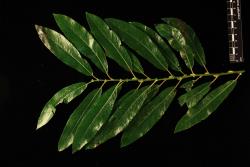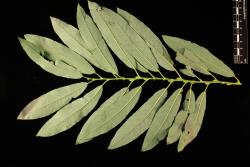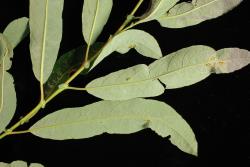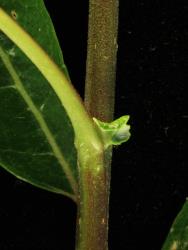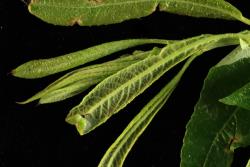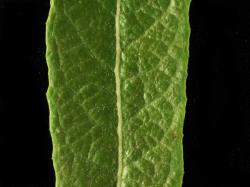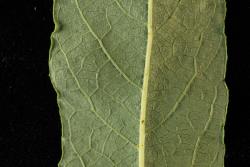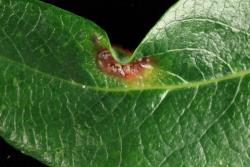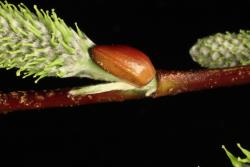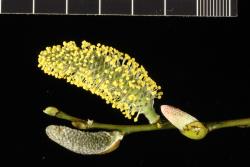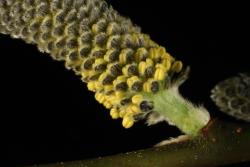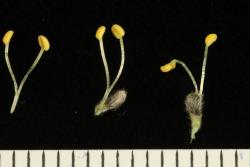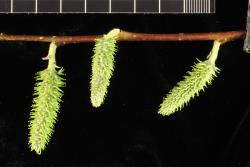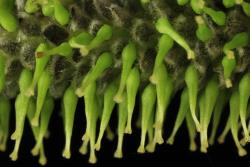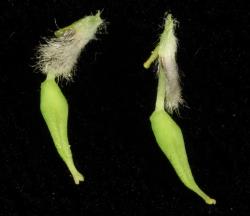Current year's branchlets glabrous, tomentose at first, hairs not persisting, strong brown (UCL55). Flower bud scales 7–11 mm long, 3.5–5.2 mm wide, 2.0–5.3 mm deep, ovoid, 2-angled, moderate yellow to dark orange-yellow (UCL87–72), glabrous. Leaves alternate. Stipule persistent, 3–9 mm long, narrowly asymmetrically ovate. Petiole 11–24 mm long, glabrous or very sparsely tomentose, groove absent, glands absent, base not expanded, pinkish brown to pinkish red. Emerging leaves tinged with orange, with sparsely to moderately densely tomentose hairs. Proximal leaves entire. Leaf lamina 95–138 mm long, 18–32 mm wide, length to width ratio 4.0–5.3:1, narrowly to very narrowly oblong-elliptical or obovate, not falcate; base cuneate or rounded; apex acute to acuminate; leaf galls absent or sparse and red; orange rust absent in late summer; margins distantly and indistinctly toothed, finely revolute, rarely plane; upper lamina surface smooth, medium glossy to very glossy, glabrous, stomata absent; lower lamina surface midvein and side-veins raised, sometimes netted veins also raised, distinctly glaucous, glabrous or sparsely tomentose, particularly near the midvein. Catkins female or male, emergence precocious to coetaneous with leaves. Flowering branch 29–65 mm long, 1–4 cataphylls and leaves on flowering branch. Male catkin 35–44 mm long, 14 mm diameter. Female catkin 28–30 mm long, 6–14 mm diameter; catkin rachis not visible between flowers. Flower bracts 1.8–3.3 mm long, 0.3–1.2 mm wide, dark brown except hyaline in proximal third, flat; apex rounded or obtuse; densely short-silky hairy, hairs obscuring the bract; female bract persistent. Male nectary 1, 0.54 mm long, 0.30 mm wide, green or yellow-green. Stamens 2, filaments, fused ca. 0.1–0.3 of their length, hairs absent; anthers 1.1 mm long, yellow. Female nectary 1, 0.7–0.9 mm long, 0.24–0.5 mm wide, yellow; ovary 3.1–4.3 mm long, glabrous, with stomata, longer than the flower bract; stipe 1.4–2.5 mm long; ovary long-tapering to a style base 0.4–0.5 mm long, style arms 0.2 mm long, unlobed, stigmas pale yellow.
Leaves are narrowly obovate or oblong-elliptical, characteristically with parallel sides at mid-leaf, but often with the leaf margins indented or distorted. Red leaf galls are sometimes present on the leaves (in New Zealand and in its native range) and contribute to this distortion. Leaves are glossy to very glossy above, glabrous or almost glabrous on all parts of the leaf including the petiole; marginal teeth are absent, the leaf apex acute (not acuminate). Stipules are persistent and obvious, ovate. The lower leaf surface may be strongly glaucous or not glaucous at all; clones present in New Zealand vary in this feature. Ovaries are glabrous on a long stipe (1.4–2.5 mm long) and the ovary tapers evenly to the style. Flower bracts are dark brown at the apex, hyaline at the base, and densely short-silky hairy on both surfaces and margins, the hairs obscuring the bract.
Leaves are most similar to those of Salix ×fragilis. Both have red leaf galls, and both have glabrous mature leaves but, hairs are present on the juvenile leaves. Salix lasiolepis has an acute leaf apex while S. ×fragilis has a very narrowly acute leaf apex. The leaf margins of S. lasiolepis are distantly serrulate with teeth very small, while in S. ×fragilis they are closely serrulate and the teeth conspicuous. The catkins of S. lasiolepis when in flower are characteristic of subgenus Vetrix: flower bracts are black-brown distally and densely long-silky hairy, but not red-tinted. Anthers are red-tinged before dehiscence and filaments glabrous and united at the base.
In cultivation and only known in the National Willow Collection in Palmerston North, with four clones (PN697, PN698, PN751, and PN752) that were collected in California for the National Willow Collection.
First collection: CHR 644782, D. Glenny, L. Newstrom-Lloyd, T. Jones, 12 October 2016, Aokautere.
First publication: This publication.
Flowering: Early August–October.
Tetraploid, 2n = 76 (CCDB, based on two counts), provisionally confirmed by flow cytometry using PN697 and PN751.



